Nonprofit crowdfunding is growing exponentially and a new way of funding for most organizations.
When it comes to raising money, nonprofit fundraisers spend a lot of time knocking on doors, crafting emails, and making phone calls. You’re getting by financially and making some friends in the process, but are you maximizing your reach? You might not be.
Chances are, if you’re not using the power of “the people” (aka your supporters) to help you raise money, then it’s likely you’re missing out on potential dollars and donors.
Your supporters are the reason why social fundraising techniques like crowdfunding are so effective. They’re why every donation, big and small, combine to make real change in your community and the world.
If you’re eager to mobilize “your people” and raise money through a nonprofit crowdfunding campaign this year, follow these 11 best practices.
Nonprofit Crowdfunding: 11 Best Practices You Can Use to Mobilize Your Community
1. Start With A Well-Defined Goal
Begin your crowdfunding campaign planning by establishing a well-defined goal. Most often, your goal begins as a dollar amount, but it should evolve from that.
You may already know that you need to raise $10,000 over the course of the campaign, but how do you plan to do it? How will you measure your success? Is that amount actually attainable? These are all questions you need to ask.
The best way to answer these questions is to follow SMART criteria to shape your goal. A SMART goal includes these elements:
- Specific
- Measurable
- Attainable
- Relevant
- Time-Based
Using the SMART formula, evolve your financial goal to a more detailed campaign-specific and impact-related goal. For example, you can say: We want to raise $10,000 during an online crowdfunding campaign over a one-month period. This money will fund a new initiative that provides music scholarships for children.
In the example below, Casa Congo put their impact-based SMART goal on display right on their fundraising website.
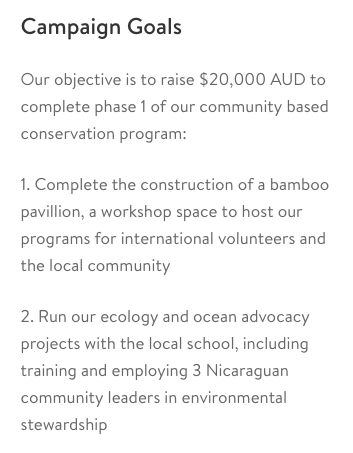
Casa Congo School campaign goal
2. Create A Thorough Plan
After you establish a clear goal, create a plan to meet that goal. Don’t worry about getting elaborate; just start with the basics, including:
- Start and end dates
- Staff and volunteers responsible
- Intended audience of donors
- Other resources needed, such as social media profiles, email, and marketing materials
- Online fundraising platform
- Key action items and dates
- Expenses and anticipated income
- Additional notes
From there, use a calendar or this template to expand and create a thorough plan that anyone in your organization can use.
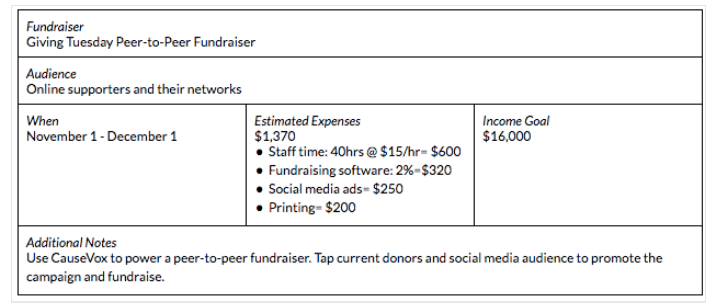
3. Spend Time On Your Website
An online crowdfunding campaign needs a high-quality website. Thankfully, when you use an online fundraising platform to power your campaign, a lot of the legwork is done for you, including all the behind-the-scenes technical components.
However, you should still spend time perfecting your website. Here are a few ways you can elevate your crowdfunding website:
- Customize the URL
- Use brand-specific colors and your organization’s logo
- Images
- Your nonprofit story
- Impact meter and other goal-specific information
Design your crowdfunding website with the same details (down to the color and font) just as you would your organization’s main website to maximum impact.
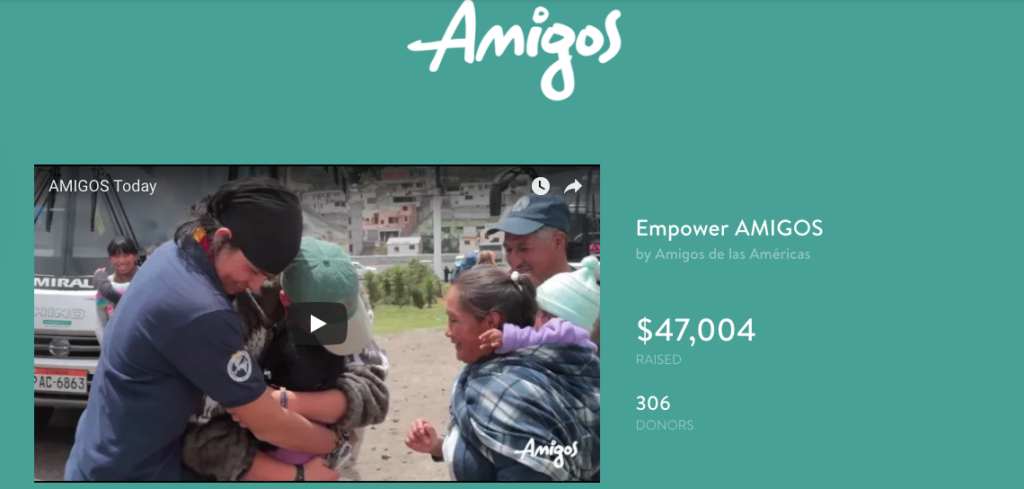
Amigos de las Americas crowdfunding website
4. Directly Link Your Impact With Donations
Remember how you crafted a goal that related the dollars you plan to raise with the intended impact? Don’t forget to use that impact figure during your crowdfunding campaign.
Impact can be educational and inspirational. It tells people exactly what they can expect to happen with their gift. At the same time, sharing information on impact helps promote transparency. Using an impact meter right in the middle of your website is always a great first step.
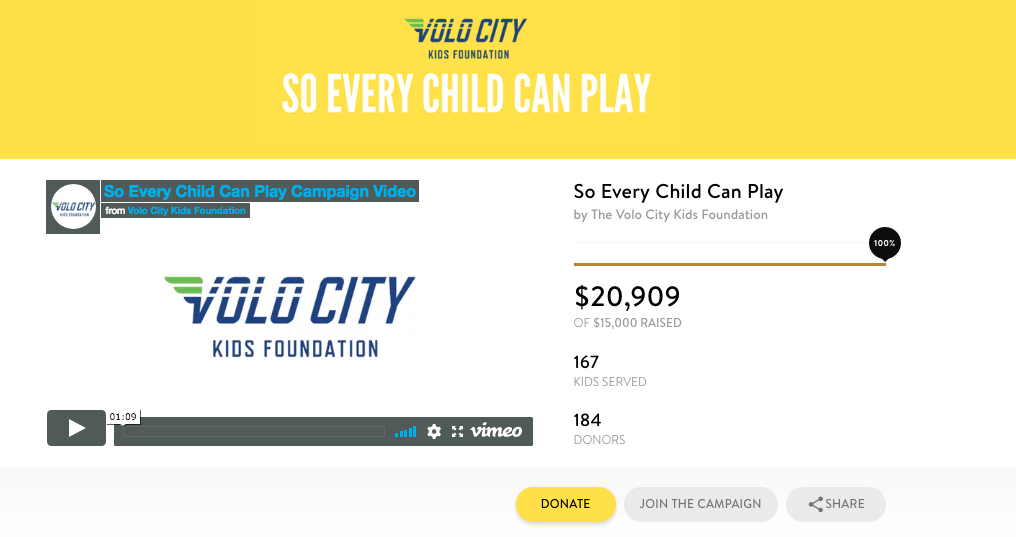
But you can also take it a step further and talk more about a gift’s impact in your nonprofit story, just like Volo City Kids Foundation.
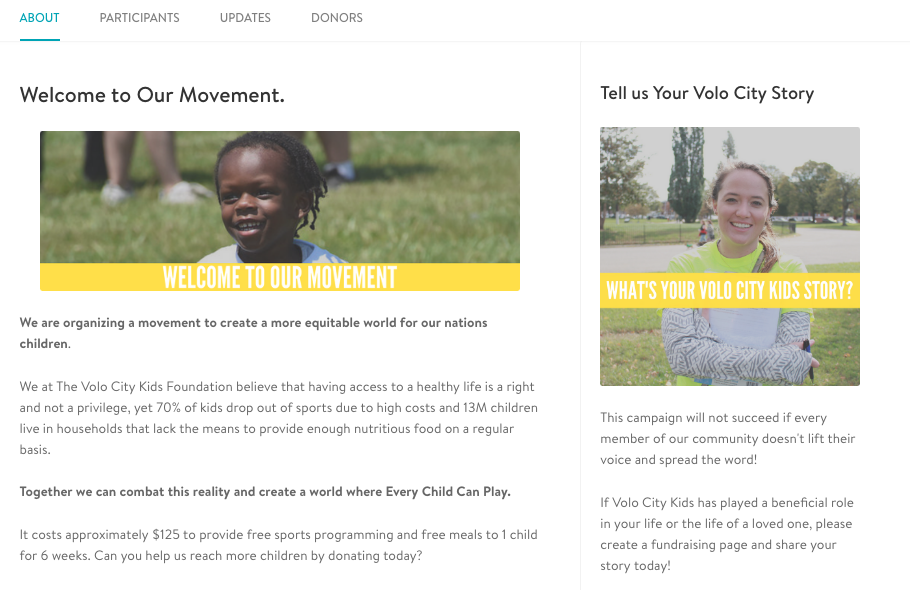
Volo City Foundation online fundraiser
5. Share A Story
You can throw facts and figures at your audience until the cows come home, but if you don’t inspire people, you’re not going to convert them from audience members to donors. Another thing to consider is that, in online crowdfunding, the vast majority of the people you’re “speaking to” are online. Therefore, the story you put out there on your website is sometimes the only information they will use to decide whether to give or not.
Nonprofit stories take many forms including written words, images, and videos. Using these media, you can share client success stories, donor testimonials, behind-the-scenes looks, and so on.
Regardless of how you share your story, it should address the problem your nonprofit helps to solve.
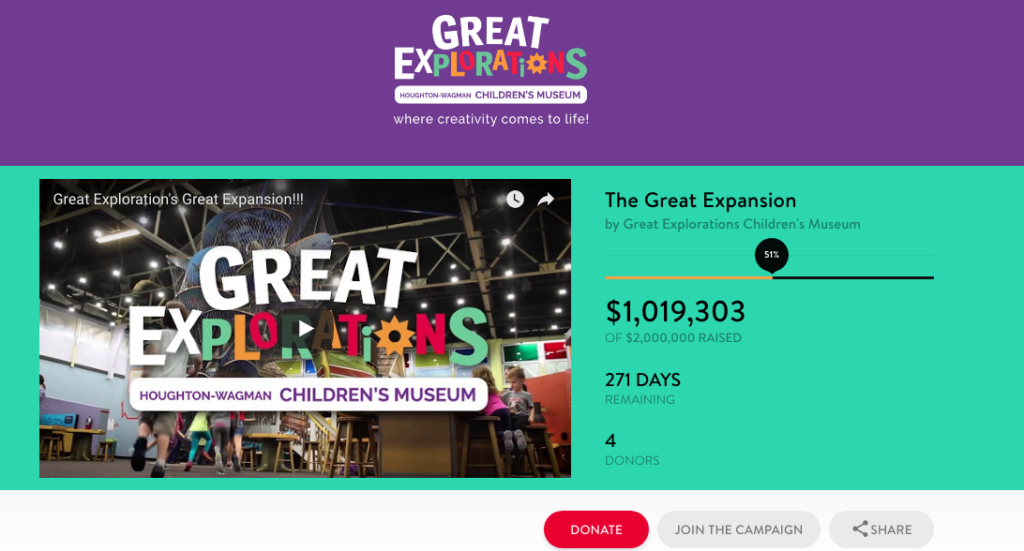
The fundraising website for Great Explorations Children’s Museum, featuring a great video story
6. Use Multi-Channel Marketing
Multi-channel marketing ensures that you’re reaching every possible donor, wherever they are. You have some supporters who prefer to read about your campaign via email, while others like Facebook. There are bound to be donors who want to hear about it in-person at your office, too.
Think about all the ways you reach your nonprofit audience and write them down. Then, figure out how you can share news about your crowdfunding campaign through each various channel.
Your supporters can also help in this area using the online social sharing options you provide on your crowdfunding website.
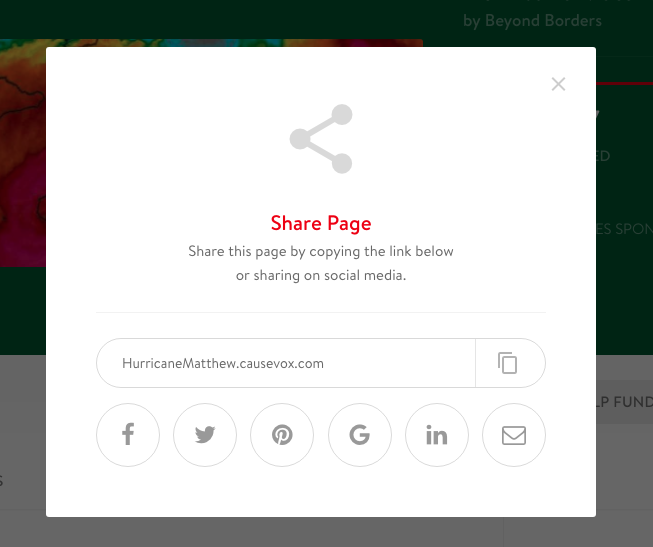
Beyond Borders offers website visitors the option to “Share” the page
7. Build Your Supporter Base
Well before you kick off the crowdfunding campaign, start building your supporter base. These initial supporters are most often your board members, active volunteers, and staff. Inform them about the campaign, and get their input. Some organizations find that collecting initial donations from this core base gets the campaign off to a fast and exciting start.
Then, once your campaign officially begins, ask your core supporter base to share the campaign with their networks. This is where social sharing comes in handy, again! For example, the board of directors at the Asian American Arts Alliance played an integral role in helping power their campaign. In encouraging their board to ask friends and family to donate, this nonprofit blew past their fundraising goal.
8. Use Donor Options
Some of your donors will know exactly how much they can give and pledge it. But you’re also bound to have prospective donors that 1. haven’t given online before or 2. don’t know how much they can or should give.
Providing your donors with options helps to streamline the process for everyone involved. Two of the most common and most requested donor options are donation tiers and monthly giving.
Donation tiers are pre-suggested giving amounts. Sometimes these tiers directly related to impact (yippee!) but they don’t have to. When you use donation tiers, donors don’t have to throw out an arbitrary donation amount. Instead, they can choose an amount that your organization pre-determined.
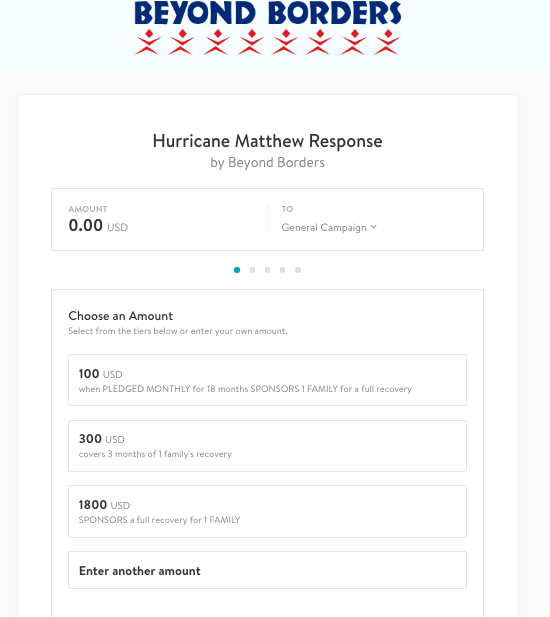
Beyond Borders Hurricane Matthew Response donation tiers
The option to give monthly appeals to donors, some of whom want to give a large gift but would like to break it up into multiple payments. Monthly donors are more easily (and cheaper) to retain, and, on average, give more over the course of the year than one-time givers.
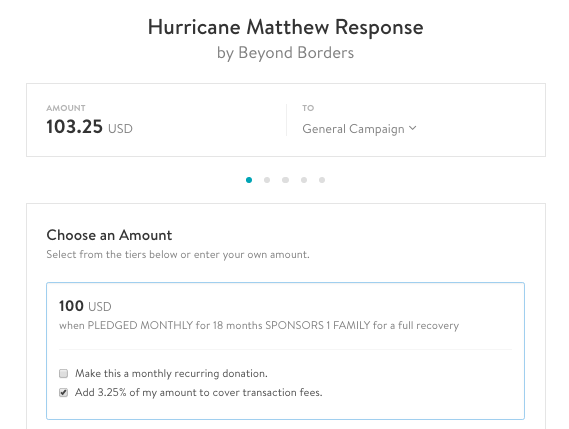
Beyond Borders monthly giving option
9. Get Help From The Media
Don’t limit your organization to your current marketing channels. In fact, there’s a big chance that your community has a robust network of media outlets ready to cover your campaign.
Contact local radio and television stations, and the newspaper. Provide them with a press release about your event and include any campaign-specific information such as start and end dates, intended impact, etc. If you have a large event gathering, note that too!
Any attention is helpful when you’re trying to draw people to your campaign.
10. Track And Adjust
A major benefit of raising money online is that you can VERY easily track your progress. As you move through the campaign, continue to track where you are compared to where you hope to be at multiple stages.
If you notice any lulls, adjust your strategy to ramp up the energy. It may take a fundraising email, a social media push, or a blog post to get the campaign going again.
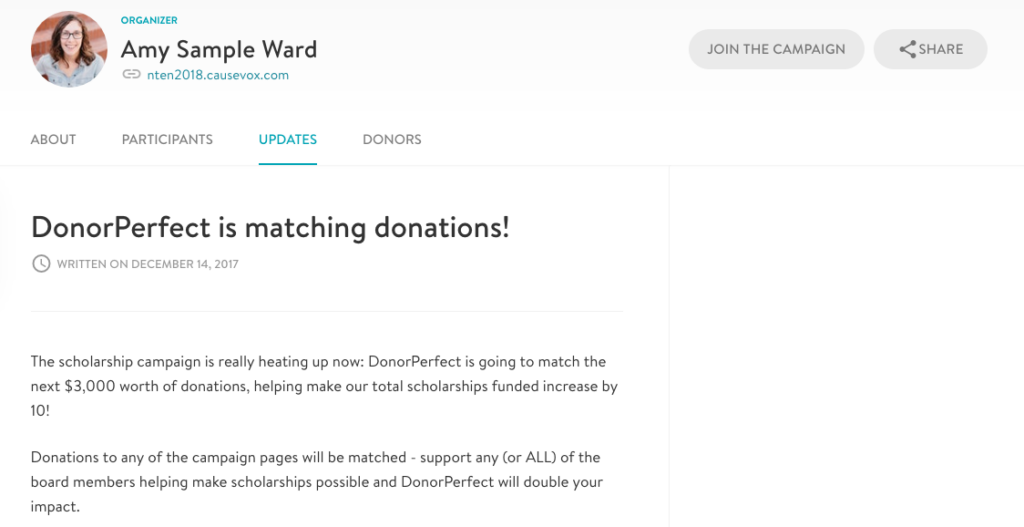
A gift match is a great way to ramp up the campaign energy and recruit new donors.
Whatever you do, don’t despair. Simply look at where you are and where you need to be, and then put action steps in place to get the job done.
11. Ask for Feedback
Closing out the campaign doesn’t mean your job is done yet. While you’re compiling results and reporting them, don’t forget to ask you supporters (this includes everyone from your donors to your board members) for feedback.
Create a campaign-specific survey that asks supporters questions such as:
- Was it easy to donate?
- What compelled you to give?
- Can we add you to our email list?
You can also send out a Net Promoter Score Survey to understand your supporter’s big picture view of your organization.
All feedback is helpful, even when it stings. Use it to adapt your crowdfunding strategies moving forward.
Crowdfunding is a superb fundraising technique that every nonprofit, regardless of size or mission, can use to raise money and friends. By setting up a crowdfunding campaign and following these best practices, you’re one step closer to online fundraising success.
To get started with your own crowdfunding campaign, start here. You can also check out these additional resources:
Here’s our presentation that we gave to raving reviews at Camp Finance (NYCON), 501TechNYC (NTEN), and Society for Nonprofits. This presentations is focused on “beginner” crowdfunders in the marketing/fundraising role.
Let me know if you have any thoughts or comments. Share this presentation if you like it!
This post was originally published in July 2014 and has been updated for freshness, accuracy, and comprehensiveness.




